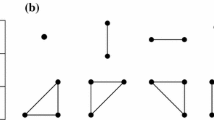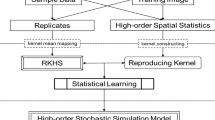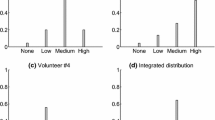Abstract
A new approach is described to allow conditioning to both hard data (HD) and soft data for a patch- and distance-based multiple-point geostatistical simulation. The multinomial logistic regression is used to quantify the link between HD and soft data. The soft data is converted by the logistic regression classifier into as many probability fields as there are categories. The local category proportions are used and compared to the average category probabilities within the patch. The conditioning to HD is obtained using alternative training images and by imposing large relative weights to HD. The conditioning to soft data is obtained by measuring the probability–proportion patch distance. Both 2D and 3D cases are considered. Synthetic cases show that a stationary TI can generate non-stationary realizations reproducing the HD, keeping the texture indicated by the TI and following the trends identified in probability maps obtained from soft data. A real case study, the Mallik methane-hydrate field, shows perfect reproduction of HD while keeping a good reproduction of the TI texture and probability trends.



















Similar content being viewed by others

References
Al-Mudhafer WJ et al (2014) Multinomial logistic regression for bayesian estimation of vertical facies modeling in heterogeneous sandstone reservoirs. In: Offshore Technology Conference-Asia, Offshore Technology Conference
Almeida AS, Tran T, Ballin PR (1993) An integrated approach to reservoir studies using stochastic simulation techniques. In: Soares A (ed) Geostatistics Troia’92, pp 371–383
Arpat GB, Caers J (2007) Conditional simulation with patterns. Math Geol 39(2):177–203
Bellefleur G, Riedel M, Brent T (2006) Seismic characterization and continuity analysis of gas-hydrate horizons near Mallik research wells, Mackenzie Delta, Canada. Lead Edge 25(5):599–604
Caers J, Ma X (2002) Modeling conditional distributions of facies from seismic using neural nets. Math Geol 34(2):143–167
Chugunova TL, Hu LY (2008) Multiple-point simulations constrained by continuous auxiliary data. Math Geosci 40(2):133–146
Daly C (2005) Higher order models using entropy, markov random fields and sequential simulation. In: Leuangthong O, Deutsch CV (eds) Geostatistics Banff 2004. Springer, Berlin, pp 215–224
de Vries L, Carrera J, Falivene O, Gratacos O, Slooten L (2009) Application of multiple point geostatistics to non-stationary images. Math Geosci 41(1):29–42
Dobson AJ, Barnett A (2008) An introduction to generalized linear models. CRC Press, Boca Raton
Dreiseitl S, Ohno-Machado L (2002) Logistic regression and artificial neural network classification models: a methodology review. J Biomed Inform 35(5):352–359
Dubreuil-Boisclair C, Gloaguen E, Bellefleur G, Marcotte D (2012) Non-gaussian gas hydrate grade simulation at the Mallik site, Mackenzie Delta, Canada. Mar Pet Geol 35(1):20–27
Efros AA, Freeman WT (2001) Image quilting for texture synthesis and transfer. In: Proceedings of the 28th annual conference on computer graphics and interactive techniques, ACM, pp 341–346
El Ouassini A, Saucier A, Marcotte D, Favis BD (2008) A patchwork approach to stochastic simulation: a route towards the analysis of morphology in multiphase systems. Chaos Solitons Fract 36(2):418–436
Faucher C, Saucier A, Marcotte D (2013) A new patchwork simulation method with control of the local-mean histogram. Stoch Environ Res Risk Assess 27(1):253–273
Faucher C, Saucier A, Marcotte D (2014) Corrective pattern-matching simulations with controlled local-mean histogram. Stoch Environ Res Risk Assess 28(1):2027–2050
Fisher SRA, Fisher RA, Genetiker S, Fisher RA, Genetician S, Fisher RA, Généticien S (1960) The design of experiments, vol 12. Oliver and Boyd, Edinburgh
Goovaerts P (1997) Geostatistics for natural resources evaluation. Oxford University Press, Oxford
Guardiano F, Srivastava M (1993) Multivariate geostatistics: beyond bivariate moments. In: Soares A (ed) Geostatistics Troia’92, vol 5, pp 133–144
Higdon D, Swall J, Kern J (1999) Non-stationary spatial modeling. Bayesian Stat 6(1):761–768
Hosmer DW Jr, Lemeshow S, Sturdivant RX (2013) Applied logistic regression, vol 398. Wiley, New york
Lee SJ (2005) Models of soft data in geostatistics and their application in environmental and health mapping. PhD thesis, University of North Carolina at Chapel Hill
Liang M, Marcotte D (2015) A class of non-stationary covariance functions with compact support. Stoch Environ Res Risk Assess. 10.1007/s00477-015-1100-y
Lu B, Torquato S (1992) Lineal-path function for random heterogeneous materials. Phys Rev A 45(2):922
Mahmud K, Mariethoz G, Caers J, Tahmasebi P, Baker A (2014) Simulation of earth textures by conditional image quilting. Water Resour Res 50(4):3088–3107
Marcotte D (1996) Fast variogram computation with FFT. Comput Geosci 22(10):1175–1186
Mariethoz G, Caers J (2014) Multiple-point geostatistics: stochastic modeling with training images. Wiley, New York
Mariethoz G, Renard P, Straubhaar J (2010) The direct sampling method to perform multiple-point geostatistical simulations. Water Resour Res 46(11):1–14
Mariethoz G, Straubhaar J, Renard P, Chugunova T, Biver P (2015) Constraining distance-based multipoint simulations to proportions and trends. Environ Model Softw 72:184–197
McFadden D et al (1973) Conditional logit analysis of qualitative choice behavior. University of California, California
Paciorek CJ, Schervish MJ (2006) Spatial modelling using a new class of nonstationary covariance functions. Environmetrics 17(5):483–506
Pickard DK (1980) Unilateral markov fields. Adv Appl Probab 12:655–671
Pohar M, Blas M, Turk S (2004) Comparison of logistic regression and linear discriminant analysis: a simulation study. Metodoloski zvezki 1(1):143
Press SJ, Wilson S (1978) Choosing between logistic regression and discriminant analysis. J Am Stat Assoc 73(364):699–705
Rezaee H, Mariethoz G, Koneshloo M, Asghari O (2013) Multiple-point geostatistical simulation using the bunch-pasting direct sampling method. Comput Geosci 54:293–308
Rezaee H, Asghari O, Koneshloo M, Ortiz J (2014) Multiple-point geostatistical simulation of dykes: application at Sungun Porphyry Copper System, Iran. Stoch Environl Res Risk Assess 28:1913–1927
Rezaee H, Marcotte D, Tahmasebi P, Saucier A (2015) Multiple-point geostatistical simulation using enriched pattern databases. Stoch Environ Res Risk Assess 29:893–913
Rivest M, Marcotte D (2012) Kriging groundwater solute concentrations using flow coordinates and nonstationary covariance functions. J Hydrol 472:238–253
Shamsipour P, Marcotte D, Chouteau M, Rivest M, Bouchedda A (2013) 3D stochastic gravity inversion using nonstationary covariances. Geophysics 78(2):G15–G24
Stein ML (1999) Interpolation of spatial data: some theory for kriging. Springer, Berlin
Straubhaar J, Renard P, Mariethoz G, Froidevaux R, Besson O (2011) An improved parallel multiple-point algorithm using a list approach. Math Geosci 43(3):305–328
Strebelle S (2002) Conditional simulation of complex geological structures using multiple-point statistics. Math Geol 34(1):1–21
Tahmasebi P, Hezarkhani A, Sahimi M (2012) Multiple-point geostatistical modeling based on the cross-correlation functions. Comput Geosci 16(3):779–797
Tahmasebi P, Sahimi M, Caers J (2014) Ms-ccsim: accelerating pattern-based geostatistical simulation of categorical variables using a multi-scale search in fourier space. Comput Geosci 67:75–88
Wong P, Jian F, Taggart I (1995) A critical comparison of neural networks and discriminant analysis in lithofacies, porosity and permeability predictions. J Pet Geol 18(2):191–206
Xu W, Tran TT, Srivastava RM, G JA, (1992) Integrating seismic data in reservoir modeling; the collocated cokriging alternative. SPE Annual technical conference and exhibition, Society of Petroleum Engineers, Washington, DC, pp 833–842. 4–7 October
Zhang T, Switzer P, Journel A (2006) Filter-based classification of training image patterns for spatial simulation. Math Geol 38:63–80
Acknowledgments
Authors would like to express their thanks to C. Dubreuil-Boisclair and E. Gloaguen for providing the data set for real case on Mallik gas hydrate field. Research was partly financed by NSERC (RGPIN-2015-06653). Numerous comments from three anonymous reviewers were helpful in improving significantly the manuscript.
Author information
Authors and Affiliations
Corresponding author
Rights and permissions
About this article
Cite this article
Rezaee, H., Marcotte, D. Integration of multiple soft data sets in MPS thru multinomial logistic regression: a case study of gas hydrates. Stoch Environ Res Risk Assess 31, 1727–1745 (2017). https://doi.org/10.1007/s00477-016-1277-8
Published:
Issue Date:
DOI: https://doi.org/10.1007/s00477-016-1277-8



